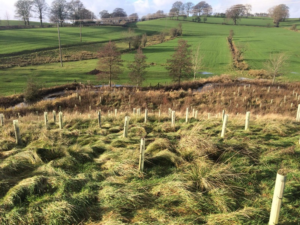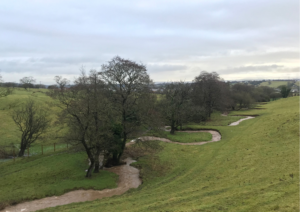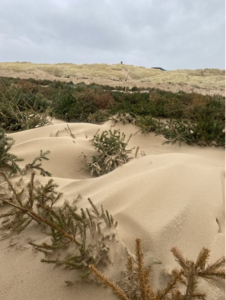This blog has been written by The Flood Hub People.
Natural Flood Management (NFM) is all about working with nature to manage flood risk. It mimics the natural functions seen across a river catchment, such as: restoring rivers, planting woodlands, re-wiggling rivers, or re-wetting moorlands. And the best thing about NFM? It doesn’t just help protect communities living at risk of flooding, it also brings a host of other benefits for people, wildlife and the environment.
NFM is becoming an increasingly viable and practical option to tackle the risk of flooding, especially as climate change brings more frequent and intense rainfall. Traditional hard engineering solutions, like constructing large flood walls, are effective however, they’re expensive, disruptive, the design and construction process can take several years, and the benefits for biodiversity aren’t significant. Contrary to this, NFM projects create thriving green spaces for society, provide rich habitats for plants and animals, improve the water quality, and store carbon.
Peatlands, for example, only cover about 3% of the Earth’s land surface, but they store three times more carbon than all the world’s forests. Unfortunately, many peatlands have been damaged by pollution, drainage and over-grazing. When this happens, surface water run-off happens at a significant rate, thus increasing flood risk. But when peatlands are restored and re-wetted, mosses like Sphagnum Moss start to grow which stabilises the peat. These mosses act like giant sponges, soaking up water, filtering pollutants, and slowly releasing water over time. Sphagnum Moss can hold up to 50 times its own weight in water!

Image: The Flood Hub
Woodland creation is another great example. Trees soak up rainfall and encourage water to infiltrate into the ground, reducing surface runoff. They also provide vital habitats for wildlife, improve soil structure, and store carbon. Sound soil structure is better for farmers too. It can become more nutrient rich for sustainable grazing or planting, and stronger soil is eroded less easily, which means less erosion during heavy rain and less run off from farmlands.
Every £1 spent on NFM creates £10 worth in benefits.
A recent study which assessed 10 different Wildlife Trust projects found that collectively, NFM projects deliver an average cost-benefit ratio of 4:1 over 10 years, but this figure rises to 10:1 over 30 years, thus making it the more viable and desirable option for many communities living at flood risk.

Image: The Flood Hub
For centuries, rivers were artificially straightened, canalised or separated from the natural floodplain to allow rivers to flow faster, drain the surrounding land for fields, provide space for infrastructure like roads and protect houses from flooding. However, over time we realised that this was ineffective as increasing the velocity resulted in significantly heightened flood risk for communities living downstream. Re-wiggling rivers brings the natural meanders back to watercourses, which slows the flow and allows for greater water storage which has a substantial impact on reducing the velocity and flow of which water travels downstream.

Image: The Flood Hub
Coastal natural flood management measures can help to restore coastal processes and coastal habitats. Techniques like restoring salt marshes and mudflats, reinforcing sand dunes or replenishing beaches all help to dissipate wave energy at the shorelines. Sand dunes act as a natural buffer, protecting coastal towns from the strong storm surges. One project along the Fylde Coast, sees Christmas Trees buried into trenches following the festive period. The pine trees trap windblown sand and encourage vital coastal plants like Marram Grass which stabilise the dunes. Following many successful years of the Fylde Sand Dunes Project, the Fylde Coast made the ideal location to reintroduce the Sand Lizard, the UK’s rarest lizard species. This is now the most northerly site in England where Sand Lizards can be found!
While NFM won’t always prevent flooding on its own, it is a cost-effective, sustainable and environmentally beneficial solution which complements hard engineering schemes.